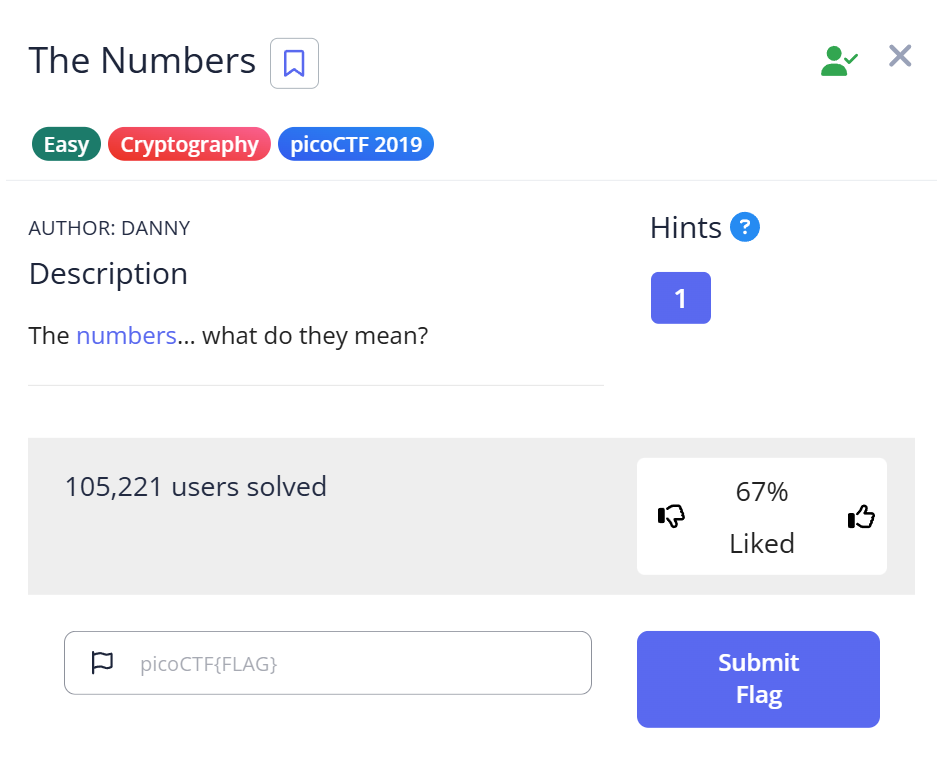Description
The numbers… what do they mean?
📝 Challenge Overview
In this challenge, we are given a sequence of numbers that correspond to letters in the alphabet (e.g., 1 = A, 2 = B, 3 = C, …). By recognizing this simple substitution, we can decode the message to reveal the flag. We can solve this easily using an online tool like dCode’s Letter‑Number Cipher.
🔢 Step 1: Identify the cipher type
- Examine the numbers provided in the challenge.
- Notice that the numbers match the order of the alphabet (1 = A, 2 = B, etc.).
- Conclude that the message uses a Letter-Number substitution cipher.
📝 Explanation: Many beginner CTFs encode letters as numbers to hide simple text. Recognizing patterns like sequential numbers often points to an A=1, B=2 mapping.
🌐 Step 2: Decode the numbers using a web tool
- Open dCode’s Letter-Number Cipher.
- Enter the number sequence from the challenge into the tool.
- The tool converts the numbers to letters automatically, revealing the hidden text or flag.
📝 Explanation: Online cipher tools like dCode allow beginners to decode common ciphers quickly without manual calculation. This is very useful for time‑sensitive challenges or initial learning.
🏁 Capture the Flag
📎 After decoding with the Letter-Number Cipher tool, you will obtain the flag:(example: picoCTF{a_simple_number_cipher})
(Replace with the actual decoded flag from your challenge.)
📊 Summary
| Step | Command / Action | Purpose | Key Result |
|---|---|---|---|
| 1 | Examine number sequence | Identify cipher type | Recognized Letter-Number substitution |
| 2 | dCode Letter-Number Cipher | Decode numbers into letters | Revealed flag text |
💡 Beginner Tips
- 🔢 Look for simple patterns: sequential numbers often indicate A=1, B=2 mapping.
- 🌐 Use web tools like dCode for common ciphers (Letter-Number, ROT13, Base64).
- 📝 Double-check the mapping; sometimes numbering starts at 0 instead of 1.
- ⚡ For practice, try decoding manually to understand the substitution logic.
🎓 What you learn (takeaways)
- Numbers can encode letters using a simple substitution cipher.
- Pattern recognition (like sequential numbers) is key to identifying the cipher.
- Web-based tools are a practical way to speed up decoding for beginners.
- Understanding simple ciphers prepares you for more complex encoding challenges.
⚡ Short explanations for commands / techniques used
- 🔢 Letter-Number substitution
- What: Each number represents a letter (1 = A, 2 = B, …).
- Why: Simple method to hide text in plain sight.
- How: Convert numbers to letters manually or using a tool.
- 🌐 dCode Letter-Number Cipher
- What: Online tool to decode numbers into letters automatically.
- Why: Useful for beginners to quickly verify results.
- How: Paste the number sequence → click “Decode” → get the letter string.
